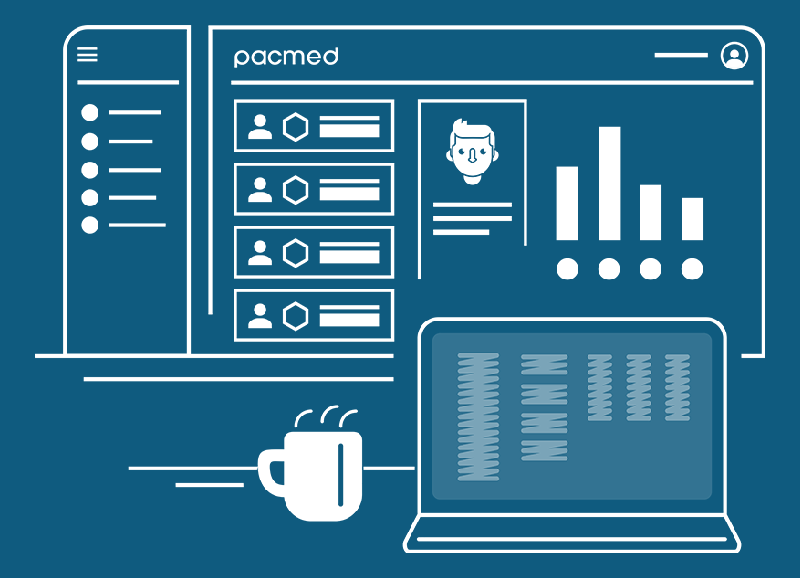Determining the optimal moment to discharge a patient from intensive care (IC) is a complicated decision for intensivists. Pacmed has developed software that supports intensivists in making this complex decision: Pacmed Critical. Based on thousands of characteristics of the admission and patient, Pacmed Critical offers the intensivist a clear overview of all information necessary to reach the right decision. This helps prevent unnecessary readmissions and long hospital stays. ‘Based on data from the past, the algorithm shows the chance that a discharged patient would be readmitted within a week or would come to pass away. In this way, we are increasing the quality and effectiveness of healthcare,’ states Willem Herter, director of Pacmed.
Pacmed Critical was developed in coöperation with the Amsterdam UMC. Choosing the IC was deliberate. Indeed, the algorithm requires enough data of sufficient quality to train itself. Besides available data being an important factor in choosing whether to develop a predictive model, other factors also play a part. Think of the quality of the added value of the technology, and the impact on patients, healthcare professionals, hospitals and those paying for insurance. ‘We think it’s very important that the algorithm actually answers specific and urgent issues in practice,’ says Herter. For that reason, much consulting took place with intensivists, to find out where the biggest added value of a predictive model was in practice. From this the complex, routine decision of whether or not to discharge patients from the IC emerged as a suitable case.
Through the intelligent use of machine learning, it’s possible to maintain an overview of, and recognise patterns in the large amount of data that is continuously generated in the IC. In doing so, the intensivists are provided with insight into the development of the prediction, and what influences the chance of readmission. Herter: ‘We find this transparency crucial. We only implement machine learnings of which it is clear how the result for that individual patient came to be, so the practitioner is able to critically evaluate the information and place it in the right context.’ By integrating this kind of technology appropriately in the daily procedures of healthcare professionals, Pacmed is creating synergy between computers and the irreplaceable knowledge of healthcare professionals. Herter: ‘We at Pacmed are convinced that an algorithm cannot and may not make a decision autonomously.’ In order to create enough support for the implementation of the algorithm within the organisation, Herter says it is important to act according to several core principles. Think of the guarantee of responsible use of medical data and results. Also, use the technological application to answer specific issues in practice. Moreover, Pacmed Critical is scientifically validated. They also recently received a CE certification. During the entire implementation process, healthcare professionals were continuously included in the calibration of the algorithm. Even after the implementation, healthcare professionals remain closely involved with the continued development.
In the meantime, the first steps have been taken towards the implementation of Pacmed Critical at several other academic and specialised clinical hospitals, including the Elizabeth-TweeSteden Ziekenhuis (ETZ). Herter: ‘During the scale-up of Pacmed Critical, we need to take into account that every hospital is different. For example, there are differences between the population of the Amsterdam UMC and the ETZ. Therefore it is not self-evident that the algorithm developed for the Amsterdam UMC will have the same predictive prowess in the ETZ. Besides, it often differs per hospital how data is registered, monitored, and stored.’ Pacmed has developed a scaleable and reusable infrastructure, in cooperation with healthcare professionals, which can deal with the differences in population and logistics between hospitals. ‘This makes it simpler to test and validate Pacmed Critical in other hospitals’, says Herter. Without adjustments, many of the systems aren’t interoperable, Herter states. In order to work towards a more data-driven healthcare, it is important to start collecting data in healthcare in a more standardised way. Besides that, (future) doctors, perhaps with assistance, will have to continue to look critically at the added value of artificial intelligence (AI) applications. Finally, Pacmed is actively looking for partnerships with other chain partners. The benefits are, after all, not always for the parties that invest in new technological innovations. The implementation of Pacmed in the ETZ, for example, was made possible by CZ’s My Best Treatment programme.
Pacmed wants to expand Pacmed Critical in the future, with algorithms that support intensivists in more daily decision-making. A capacity planner for the IC was also developed, and is currently being tested. Besides that, Pacmed will develop a wider array of algorithms. In part because of the Coronavirus crisis, it has where the most urgent issues are where Pacmed could make a difference


